FROG OR TOAD? 10 WAYS TO TELL THE DIFFERENCE
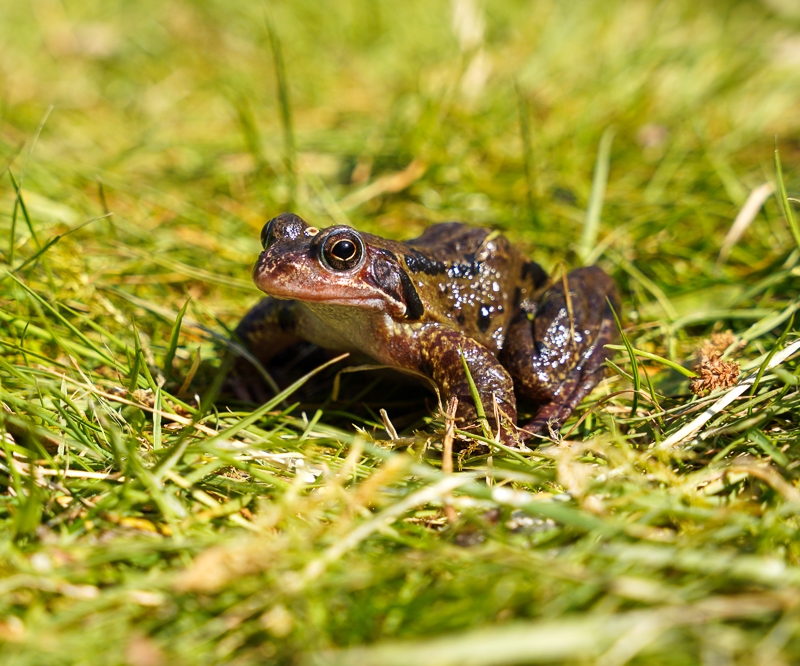
A common frog
Frogs and toads look very similar unless you look closely. Here are some tips to tell them apart.
1. Frogs look wet, toads look dry
This is the easiest way to tell what you’re looking at and is the way I usually make a positive identification.
Frogs are the lip gloss of the amphibian world: shiny, gleaming, glamorous. Toads are the matt lipstick of the amphibian world: classy, understated, sophisticated.
2. Frogs are smooth, toads are warty
It’s true that toads are warty, but it isn’t usually as obvious as is made out by Halloween illustrations. Frogs are said to have smooth skin, but they do sometimes have small bumps which can be mistaken for the warts of a toad.
The warts on a toad are irregular - scattered across the skin of the toad and of varying size, unlike the uniform bumps of a frog's backbone. Behind the eyes, there's an elongated swollen bit called the parotid which releases a nasty liquid into the mouth of whatever is trying to eat the toad.
In the UK, our toads don't have particularly distinctive warts - especially baby toads - so you'll usually need to combine this observation with others to make a positive identification.
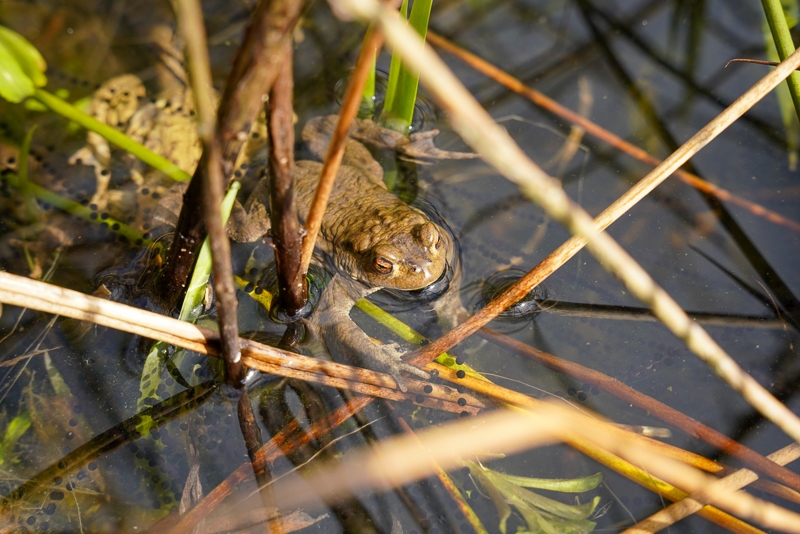
A toad's warts aren't as obvious as you may think
3. Frogs have a pointy face, toads have a flat one.
If the shape of the amphibian's face is broad and round, it's a toad. If it's narrow and pointy, it's a frog. Making this distinction might require you to look at a few different frogs and toads so you have a reference point, but is quite easy to see once you're accustomed to the different shapes.
4. Frogs lay clumps of spawn, toads lay lines of spawn
Most people are familiar with the appearance of frog spawn: round, clear jelly-like shapes with a black dot in the middle, arranged together in an untidy clump on the surface of the water.
Toad spawn is different: it's neat and ordered, arranged in double rows and often wrapped around leaves or sticks. It's often fully submerged and the clear jelly around the eggs is less obvious: the spawn looks more like a string of black beads.
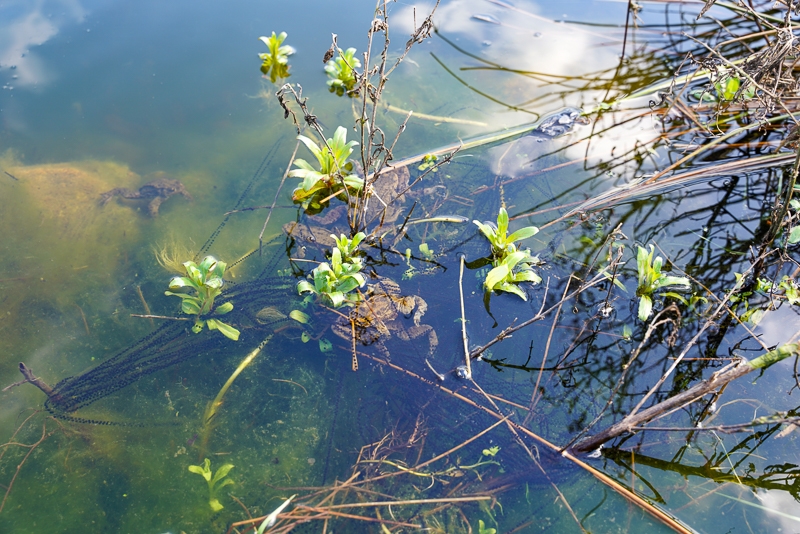
Toads in spawn. You can see the spawn wrapped around the stick.
5. Frogs have long legs; toads have short legs.
There’s a reason humans eat frogs’ legs not toads’ legs; frogs’ legs are longer than their head and body, but toads' legs aren’t. Again, this one is less helpful, because toads’ legs are still quite long – sometimes as long as their body.
More to the point, you're usually not able to stretch the amphibian's legs out and measure them (please don't try). What you can do, though, is look at the folded legs when the amphibian is sitting - frogs' come much higher above their body, but you'll need to spend some time looking at amphibians before you can make that distinction quickly.
6. Frogs hop loads, toads not so much.
This is our first red herring. It's often said that frogs hop and toads don't, so if you see an amphibian hopping purposefully along then it's a frog, but the thing is toads do hop (or jump, at least), they just don’t hop as often, as high or as far. Equally, frogs walk occasionally, so don’t rely on this one for your identification.
In a delightful book from 1946 called Animal Life of the British Isles, Edward Step says that the toad is 'a heavier, more grovelling creature than the vaulting frog' and that, consequently, 'he is too heavy to leap; instead, he progresses by very short jumps on all four feet which give the impression of being accomplished only by a great effort'.
Statistically, it's probable that a toad will walk and that a frog will hop, but if you watch one or hold one, it's entirely possible that you get a frog that walks or a toad that jumps.
7. Frogs stay near water; toads venture further afield.
Lots of posts say location is a key to identifying an amphibian. The accepted wisdom is that if you see an amphibian further away from water, it's probably a toad.
This is certainly true, but it's still a red herring for identification purposes. Toads are more tolerant of drier conditions, so they are more likely to be found away from water, but frogs can be found a little way from water too. Remember that all amphibians are adapted to take oxygen from both the water and the air for a reason; both frogs and toads spend much of the year in cool, damp places away from the pond where they breed.
One location clue you can rely on is how the amphibian is sitting. Frogs sit as you'd expect, but toads (to quote Step again) '[have] the homing faculty well developed.' The toad, says Step, 'by the judicious wriggling of his hind-quarters scoops out a hollow in the soil'. Toads dig themselves a little depression, and sit flat in it almost level with the surface. They're very well camouflaged when they do this; apparently they are 'frequently passed by as a lifeless clod', which seems rather harsh.
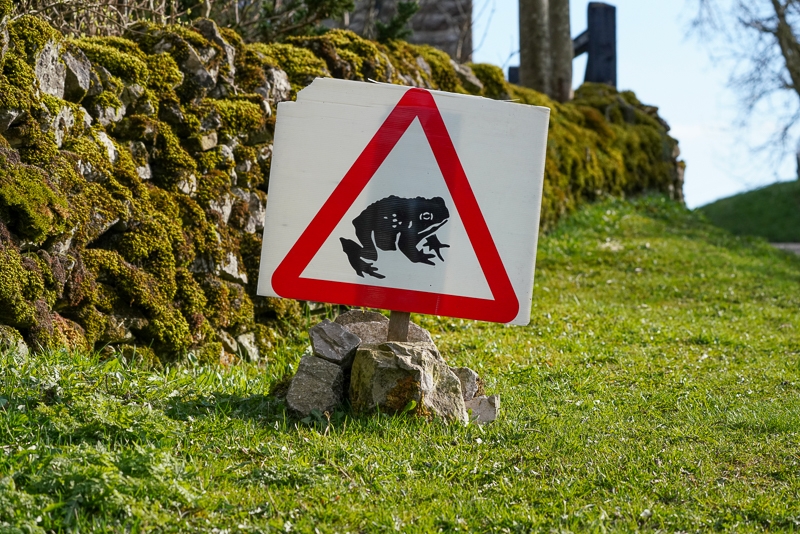
8. Frogs are yellowy green, toads are brown
Broadly speaking, frogs are a yellowy green colour, with a brown patch behind their eyes. Toads tend to be more drab, usually a brown or grey colour.
You've guessed it - this is another red herring. Although this distinction is true at scale, individually amphibians vary wildly in their colouring, and I've seen as many brown-looking frogs as I have yellow-looking toads!
9. Frogs are skinny, toads are chunky
Generally, frogs look slim and athletic whereas toads look squat and dumpy. Focusing on shape, though, can be a bit misleading - and it's not very helpful when trying to tell babies apart, as young frogs and toads have very similar body shapes.
I find it more helpful to look at their back. Frogs have a raised part of their back - almost like a sharp hunchback (it's actually their pelvis) - whereas toads' backs are much more flat.
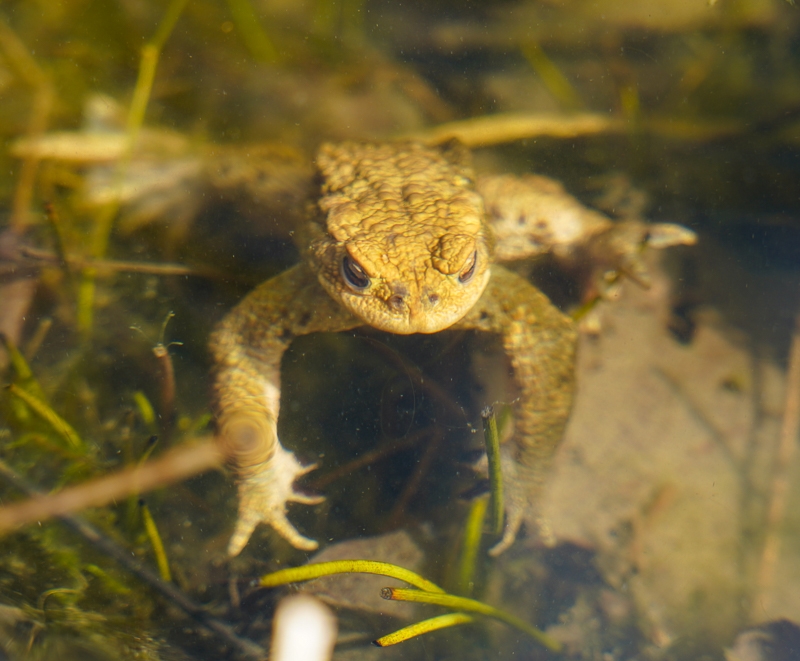
A common toad
10. Frogs have green eyes, toads have golden eyes
If you're staring into the eyes of an amphibian you may notice, as I have done, that toads' eyes often shine a deep, coppery gold. Frogs' eyes can look light gold in the sunlight, but they more often appear a dreary dark green colour.
Frogs smile, toads are disappointed in you
Okay, this one isn't strictly scientific, so it didn't get a number. I've found that frogs look smiley, and toads look like they think very little of you and the horse you rode in on.
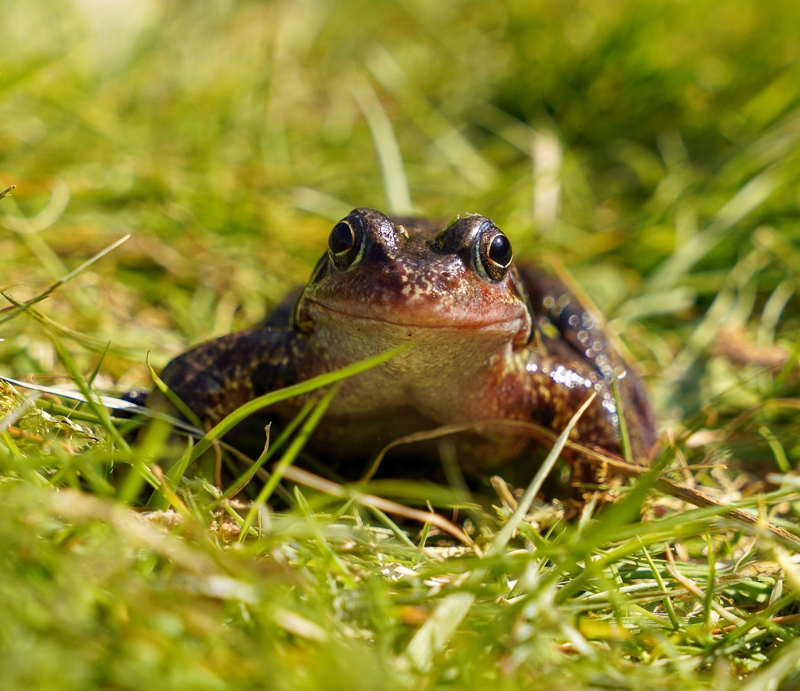
A smiling frog
GET UP CLOSE AND PERSONAL AT HOME
Want to hone your amphibian identification skills almost without leaving your sofa? Why not build a wildlife pond in your garden? Toads have suffered huge decline in recent years, and frogs are at risk from ranavirus. Building a pond is a fantastic way to help wildlife - just remember that they'll find it themselves; never move amphibians or spawn. Don't worry, they'll be there sooner than you think!
Have you seen many frogs or toads this year? Do you have any other identification tips? Let me know!
Share with your friends
Subscribe to learn more
Join me in exploring our natural world and cultural heritage as we learn how to protect and restore it. Get notified on my latest posts and a monthly newsletter on wider conversation topics for us to chat about.
Recent Posts
If you enjoyed this one, then you might like these too.